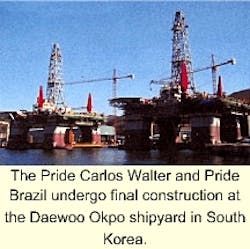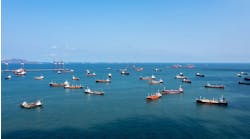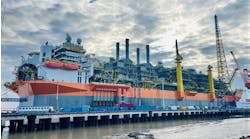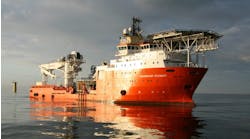While a number of ultra-deepwater drillships parade out of the world's shipyards and onto giant deepwater fields, the Pride Carlos Walter and Pride Brazil are designed for a more conservative market.
Making use of innovative technology, Amethyst, an affiliate of Pride International of Houston and Maratima Petroleo e Engenharia of Rio de Janeiro, designed these new semisubmersible rigs not for ultra-deepwater plays, but for economically developing fields in less than 5,000 ft water depths. Pride CEO Paul Bragg said these water depths account for 85% of current and prospective finds in global water depths. He said the new generation of ultra-deepwater drillships and semis can compete for the remaining 15% of the work. Amethyst is interested in offering practical, less-expensive rigs that can produce deepwater reserves in any oil price scenario.
Amethyst will soon complete construction and sea trials on the two new MODUs, which will be under contract for seven years to Petrobras. John O'Leary, Vice-President of Worldwide Marketing for Pride, said the primary drivers of this project were a reflection of the times. When the decision was made to build two new semis, the price of oil was just peaking in 1997. After the oil price collapsed, it was clear that to be economical, deepwater drilling had to focus on the fundamentals of price and versatility. That meant using the latest technology not to drill in greater water depths, but to drill more economically in deepwater and offer a variety of other support capabilities as well.
Cost scenario
O'Leary explained that while the cost of producing a bbl of oil is made up of several components, drilling costs are the largest slice of the pie. To reduce these costs, Pride set out to design and build a technically advanced rig that costs around $100 million less than the average to build.
Not only is drilling in deepwater a primary use for such rigs, but the rapid proliferation of subsea developments has increased the need for deepwater installation vessels. With such uncertainty in the oil price, O'Leary said it is preferable to have a deepwater vessel that can perform a variety of tasks. For example, these new rigs can drill deepwater wells, workover existing developments, install subsea templates, and, with modifications, perform J-lay pipeline installation.
With a variety of activities, the vessel can offer substantial savings in areas such as West Africa, where mobilization is expensive and there is little infrastructure.
The rig's designers say that deck space is not compromised, despite the reduced size of the units. This was accomplished by moving riser storage from the deck to one of the columns, consequently lowering the center of gravity of the unit. Vertically storing the riser meant a new handling system had to stab into the riser from above and lift it out of the column. The handling system would then lay the joint of riser flat for transport to the drill floor, where it would again be moved to a vertical attitude, before being run through the rotary table.
Vertical riser handling
Joop Roodenburg, Managing Director of Huisman-Itrec, said his company had developed such a system and was looking for a contractor willing to be the first to use it. The key to this technology is the riser handling crane that can rotate to stab into the riser joint, then lift it completely clear of the vessel column. The crane and riser then rotate 90°, so that the riser joint is cradled in the crane. The horizontal crane and riser section then travel horizontally across the deck where the riser is lifted into the drilling tower, made up and run as with a conventional system.
For joints that do not fit the typical profile, such as the slip joint, the riser crane is able to rotate its stabbing assembly to pick up these joints from the horizontal storage location on the deck. The joints are stabbed and then lifted as the crane rotates to vertical, so that they are standing straight up, before rotating back horizontal to the cradled position, then run, as the other joints would be.
Roodenburg said, in addition to designing this unusual riser handling system, his company also designed the deck cranes on the new vessels. These cranes are cantilevered over the side of the deck to free up even more space for equipment, and also to give the riser system enough mobility to place the joints in front of the derrick.
Mud in pontoons
To further assist in lowering the center of gravity (COG) the new semis have their mud storage and several other systems in the pontoons of the vessel. These features combine to give the vessel high variable deckload capacity, relative to the ship's weight. O'Leary said the ratio is about 3,500 tons of deckload for only 11,400 tons of ship weight.
O'Leary said the new rigs could travel at 12 knots, making the transit from the Gulf of Mexico to West Africa in 15 days under the vessel's own power. This could be an important benefit if a vessel is picking up subsea equipment prior to starting a job. Such a transit speed reduces substantially the need for additional equipment barges and work boats.
The vessels are not designed to drill in waters deeper than 5,000 ft., but can operate in any area of the world, including the North Sea. The contracts with Petrobras have the vessels performing development drilling in the Marlim and Marlim South fields offshore Brazil. Once these seven-year contracts are up, there is a possibility the rigs could move into deeper water.
Jonathan Talbot, Business Development Manager with Pride, said his company is keeping its eye on emerging technologies that could allow conventional depth rigs to drill in deeper water without the expense of a major upgrade in systems. He gave the example of expandable casing, now under commercialization.




